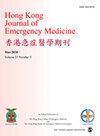香港急诊科中国短暂性缺血性发作患者的短期预后:与神经科医生达成一致协议的管理结果
IF 0.8
4区 医学
Q4 EMERGENCY MEDICINE
引用次数: 0
摘要
急诊科对短暂性脑缺血发作的管理从入院到门诊转诊各不相同。我们研究了采用商定方案治疗的短暂性脑缺血发作的短期结果。亚洲人和非亚洲人的中风预测因素可能不同。ABCD2作为短暂性脑缺血发作的初步分型是有争议的。同时对ABCD2评分的预测能力进行了研究。这是一项前瞻性观察研究,在急诊科连续招募受试者。所有短暂性脑缺血发作均已入院,对医院管理局医院急诊科、短暂性脑缺血性发作诊所、内科和神经外科的硬记录和电子记录以及一般随访进行了研究 年从症状出现到中风时间测量中风天数。在18个月的时间里,招募了124名患者。平均发病时间为3.5 h.除一例硬膜下血肿外,所有计算机断层扫描脑部阳性结果均为缺血性脑出血。6次中风,全部致残,90年内复发 第1-3天有3人死亡,第6天有2人死亡 月。2岁、7岁、90岁时的中风风险 天和1 年分别为1.61%、3.23%、4.84%和4.84%。ABCD2评分在中风风险方面没有观察到显著的趋势(p = 0.783),曲线下面积为0.537(95%置信区间 = 0.380–0.694;p = 0.762)。短期卒中风险与心房颤动相关(p = 0.002)。急诊医学病房的中位住院时间为1.33 天。在我们以急诊科为基础的管理中,短暂性脑缺血发作的短期卒中风险较低,ABCD2评分在风险分层中的预测性无法验证。中风复发与心房颤动有关。ABCD2过低可能会错误地让人放心。由于一半的中风很早就复发,我们建议在超急性期入院。本文章由计算机程序翻译,如有差异,请以英文原文为准。
Short-term outcomes of Chinese transient ischaemic attack patients in an Emergency department in Hong Kong: Result of management with an agreed protocol with neurologists
Emergency department management of transient ischaemic attack varies from admission for all to outpatient referral. We studied the short-term outcomes of transient ischaemic attack managed with an agreed protocol. Predictors of stroke can be different for Asians and non-Asians. ABCD2 as initial triage of transient ischaemic attack is debatable. The predictive ability of ABCD2 score was studied as well. This was a prospective observational study with consecutive subject recruitment in Emergency department. All transient ischaemic attacks were admitted, hard and e-records of Emergency department, transient ischaemic attack clinic, Medical and Neurosurgical department and general follow-ups in Hospital Authority hospitals were studied up to 1 year. Stroke-day was measured from symptom-onset to time-of-stroke. In 18-month period, 124 patients were recruited. The median onset-to-door time was 3.5 h. All computed tomography brain positive findings, except one subdural haematoma, were ischaemic in origin. Six strokes, all disabling, recurred within 90 days, three on day 1–3, two died in 6 months. The stroke risks at 2, 7, 90 days and 1 year were 1.61%, 3.23%, 4.84% and 4.84%, respectively. No significant trend was observed in stroke risk across ABCD2 scores ( p = 0.783) with area under the curve of 0.537 (95% confidence interval = 0.380–0.694; p = 0.762). The short-term stroke risk was associated with atrial fibrillation ( p = 0.002). The median Emergency Medicine ward length of stay was 1.33 days. In our Emergency department–based management, the short-term stroke risk of transient ischaemic attack is low, and the predictivity of ABCD2 score in risk stratification cannot be validated. Stroke recurrences were associated with atrial fibrillation. A low ABCD2 could be falsely reassuring. As half of the strokes recurred very early, we recommend admission in the hyperacute phase.
求助全文
通过发布文献求助,成功后即可免费获取论文全文。
去求助
来源期刊

Hong Kong Journal of Emergency Medicine
EMERGENCY MEDICINE-
CiteScore
1.50
自引率
16.70%
发文量
26
审稿时长
6-12 weeks
期刊介绍:
The Hong Kong Journal of Emergency Medicine is a peer-reviewed, open access journal which focusses on all aspects of clinical practice and emergency medicine research in the hospital and pre-hospital setting.
 求助内容:
求助内容: 应助结果提醒方式:
应助结果提醒方式:


